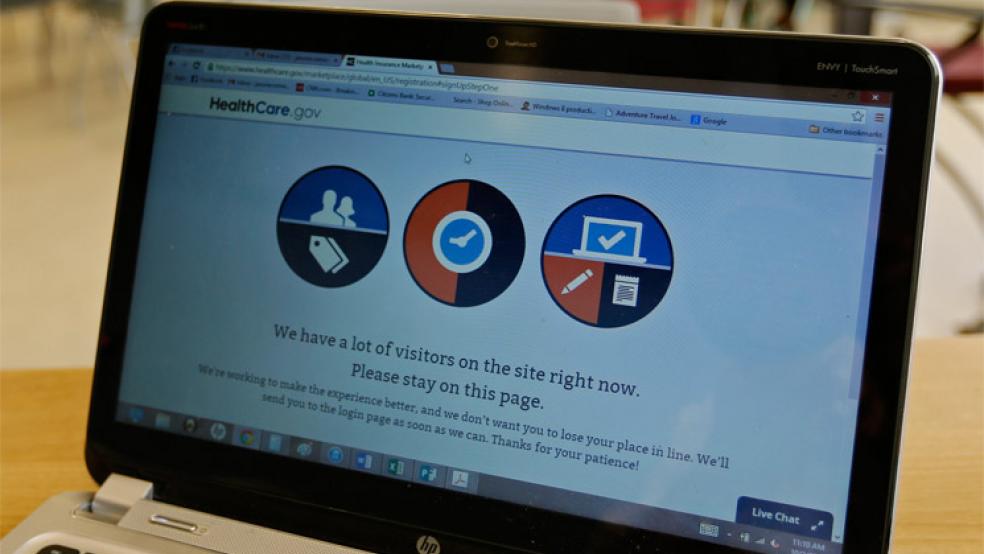The Obama administration’s main sales pitch for the Affordable Healthcare Act, better known as Obamacare, has turned out to be false: President Obama promised Americans they could keep their own insurance when the law went into effect, but some 2 million people have had their policies canceled.
Administration officials have been apologizing left and right for the multitude of problems with the site. But no one was more contrite than Health and Human Services chief Kathleen Sebelius, who laid herself at the mercy of an angry House Energy and Commerce Committee Wednesday.That’s just the first in a long series of snafus with the Obamacare rollout. The site crashes routinely. The hub that transmits information between the exchanges doesn’t function properly. Information provided to potential enrollees has been incorrect. By the administration’s own admission, the rollout has been a debacle. 
Set the political fallout from the rollout aside, and Obamacare is still the law of the land. People without insurance still must obtain it by March or face penalties. Sebelius has pledged to fix the site, but it remains to be seen how the site should be fixed in order to make it more user friendly, and how customer service should be improved.
RELATED: 4 KEY QUESTIONS SEBELIUS DIDN’T ANSWER
To get a idea of how to make the Obamacare exchanges more user-friendly, I reached out to customer service consultants to get their take on how to improve the customer’s experience. These consultants found numerous problems with the site, and suggested a number of ways that it could be improved.
1 Develop a core standard of values that will shape the entire Obamacare experience. Jill Donnelly, vice president of marketing and product development at Customer Service Experts, a consultancy in Annapolis, said that the first thing she advises clients to do is create a set of standards that will guide all subsequent work.
"If you can create those standards and an internal brand within the organization--that will seep out proactively. You have to ask yourself what's realistic and where do you want to be?"
This mission requires strong leadership that trickles down through an organization. It’s apparent now that the White House failed to provide this leadership, which lead to the disarray surrounding the signup process.
Donnelly also said that establishing core values helps employees to understand what’s expected of them. This allows them to provide better service to customers.
“If you can create an exceptional experience for your employees, those employees will create an exceptional experience for your clients,” she said.
2 Allow buyers to shop before they give information. Customer service expert Micah Solomon said that the gold standard for consumer sites are Amazon and Charles Schwab, “sites that need to be secure yet handle a lot of traffic,” he said.
Both of these sites, as well as nearly all other consumer sites, share one quality: they allow consumers to shop before they have to give up personal information.
The insurance exchanges are the exact opposite. Users are required to give up sensitive personal information before they can shop. Giving them an idea of the products available would make the shopping experience more pleasurable, as consumers would know what they’re able to purchase before they go through the checkout process.
3 Revamp the user experience. Mike Wittenstein, president and lead experience designer at StoryMiners, has the advantage of actually buying insurance for him and his family though an exchange. As someone with 25 years design experience, he had a laundry list of criticisms, as well as ideas of how it could be improved.
Wittenstein’s first observation is that he doubts the exchanges were user-tested from the start. They might have been tested once the site was near completion, but at that point it’s too late to make dramatic changes.
“I'm pretty convinced that they didn't do user testing from the very begining. If they had, the way the site works would be very different,” he said. “It’s important to include your customer in the design conversation. That includes citizens who are signing up, as well as the behind the scenes types. They’re all customers.”
“I'd fire someone if they did user testing only at the end. It needs to be baked into the beginning,” he added.
He suggested a number of ways the user experience could be improve with one-to-two day fixes. First, he’d allow users to make reservations to sign up, allowing them to plan their shopping in advance. Right now, there’s no guarantee a buyer would be able to purchase insurance when they visit an online exchange.
Second, tell users where they are in the process. For instance, right now there is no way to tell just how much more information has to be provided in order to purchase insurance. “Tell me I’m on step 3 of 10,” he said.
Third, users are inexplicably sent backwards in the sign up process, which forces they to reenter information. Wittenstein said a quick coding fix would save this information until problems with the signup process can be ironed out.
4 Give users a peek behind the curtain. Wittenstein said one of the most disconcerting aspects of signup was the vast amount of personal information he had to give up. He said he would feel much better knowing how the information was being used to get him the best possible product.
“Give a peek into the backend. It would be nice to have a sister site that shows how things work. It would appease a lot of people's curiosity and relieve a lot of stress. It’s probably one of the most complicated pieces of software built anywhere in the last years.”





